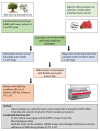Olive Leaves Extract from Algerian Oleaster (Olea europaea var. sylvestris) on Microbiological Safety and Shelf-life Stability of Raw Halal Minced Beef during Display
- PMID: 30587798
- PMCID: PMC6352275
- DOI: 10.3390/foods8010010
Olive Leaves Extract from Algerian Oleaster (Olea europaea var. sylvestris) on Microbiological Safety and Shelf-life Stability of Raw Halal Minced Beef during Display
Abstract
Oleaster (wild olive tree) by-products represent a renewable and low-cost source of biopolyphenols. Leaf extracts (sylv.OLE) of Algerian oleaster, locally called a'hachad (Olea europaea subsp. europaea var. sylvestris), were applied at 1 and 5% (v/w) to raw Halal minced beef (HMB) in order to test its safety and shelf-life prolongation during retail/display. The total phenolic compound content in the extract was 198.7 ± 3.6 mg gallic acid equivalent. Ten compounds were identified in the sylv.OLE by High Performance Liquid Chromatography/Diode Array Detector (HPLC/DAD), of which oleuropein was the most abundant (43.25%). Samples treated with 5% sylv.OLE had significantly higher antimicrobial and antioxidant effects than those treated with 1% extract (p < 0.05). The addition of sylv.OLE reduced psychrotrophic counts as well as the level of pathogens (Salmonella enterica ser. Enteritidis and Shiga toxin-producing Escherichia coli O157:H7). A thiobarbituric acid reactive substance (TBARS) value of 2.42 ± 0.11 was reached throughout six days of retail/display in control samples, while the addition of 5% sylv.OLE reduced TBARS value by 58% (p < 0.05). The presence of sylv.OLE at the tested concentrations did not negatively influence the overall acceptability and bitterness of HMB.
Keywords: Escherichia coli O157:H7; Halal minced beef; High Performance Liquid Chromatography/Diode Array Detector (HPLC/DAD); Salmonella enterica ser. Enteritidis; by-products; leaf extracts; retail/display; safety; shelf-life; wild olive tree.
Conflict of interest statement
The authors declare no conflicts of interest.
Figures





Similar articles
-
Improvement of the Shelf-Life Status of Modified Atmosphere Packaged Camel Meat Using Nisin and Olea europaea Subsp. laperrinei Leaf Extract.Foods. 2020 Sep 22;9(9):1336. doi: 10.3390/foods9091336. Foods. 2020. PMID: 32971898 Free PMC article.
-
Genetic Identification of the Wild Form of Olive (Olea Europaea var. Sylvestris) Using Allele-Specific Real-Time PCR.Foods. 2020 Apr 9;9(4):467. doi: 10.3390/foods9040467. Foods. 2020. PMID: 32283713 Free PMC article.
-
Human absorption and metabolism of oleuropein and hydroxytyrosol ingested as olive (Olea europaea L.) leaf extract.Mol Nutr Food Res. 2013 Nov;57(11):2079-85. doi: 10.1002/mnfr.201200795. Epub 2013 Jun 14. Mol Nutr Food Res. 2013. PMID: 23766098 Clinical Trial.
-
Current Status of Biodiversity Assessment and Conservation of Wild Olive (Olea europaea L. subsp. europaea var. sylvestris).Plants (Basel). 2022 Feb 10;11(4):480. doi: 10.3390/plants11040480. Plants (Basel). 2022. PMID: 35214813 Free PMC article. Review.
-
Health Effects of Phenolic Compounds Found in Extra-Virgin Olive Oil, By-Products, and Leaf of Olea europaea L.Nutrients. 2019 Aug 1;11(8):1776. doi: 10.3390/nu11081776. Nutrients. 2019. PMID: 31374907 Free PMC article. Review.
Cited by
-
Antifungal, antitoxigenic, and antioxidant activities of the essential oil from laurel (Laurus nobilis L.): Potential use as wheat preservative.Food Sci Nutr. 2020 Jul 23;8(9):4717-4729. doi: 10.1002/fsn3.1650. eCollection 2020 Sep. Food Sci Nutr. 2020. PMID: 32994933 Free PMC article.
-
Effects of an Extract from Olive Fruits on the Physicochemical Properties, Lipid Oxidation and Volatile Compounds of Beef Patties.Foods. 2020 Nov 24;9(12):1728. doi: 10.3390/foods9121728. Foods. 2020. PMID: 33255479 Free PMC article.
-
Application of Hydroxytyrosol in the Functional Foods Field: From Ingredient to Dietary Supplements.Antioxidants (Basel). 2020 Dec 8;9(12):1246. doi: 10.3390/antiox9121246. Antioxidants (Basel). 2020. PMID: 33302474 Free PMC article. Review.
-
Study the Ability of Salmonella typhimiurm to Induce Cytokine TNFα in Mice Treated with Olive Leaves Extract and Ciprofloxacin.Arch Razi Inst. 2022 Oct 31;77(5):1799-1804. doi: 10.22092/ARI.2022.358331.2196. eCollection 2022 Oct. Arch Razi Inst. 2022. PMID: 37123137 Free PMC article.
-
Combined Antimicrobial Effect of Bio-Waste Olive Leaf Extract and Remote Cold Atmospheric Plasma Effluent.Molecules. 2021 Mar 26;26(7):1890. doi: 10.3390/molecules26071890. Molecules. 2021. PMID: 33810520 Free PMC article.
References
-
- European Food Safety Authority (EFSA) Panel on biological hazards (BIOHAZ) scientific opinion on the public health risks related to the maintenance of the cold chain during storage and transport of meat. Part 2 (minced meat from all species) EFSA J. 2014;12:3783. doi: 10.2903/j.efsa.2014.3783. - DOI
-
- Carrera-Gonzalez M.P., Ramírez-Exposito M.J., Mayas M.D., Martínez-Martos J.M. Protective role of oleuropein and its metabolite hydroxytyrosol on cancer. Trends Food Sci. Technol. 2013;31:92–99. doi: 10.1016/j.tifs.2013.03.003. - DOI
Grants and funding
LinkOut - more resources
Full Text Sources
Other Literature Sources
Molecular Biology Databases

